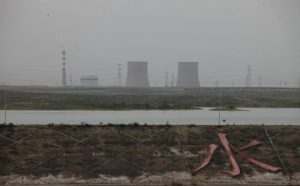Times are getting rough for Wang Guangchun, a 10-year veteran sales manager of a state-owned coal company.
"During the golden era of the past, clients came to find me," Wang said. "Starting last year, we had to go looking for them."
Wang is employed by a subordinate company of the Datong Coal Group in the northern province of Shanxi, which sits at the center of China’s coal belt. His clients have primarily been in Shanxi, Shandong and the Beijing-Tianjin-Hebei region, but recently those outside Shanxi province are growing scarcer.
"Many provinces and municipalities have issued policies for coal designated for electricity, which force power plants to use local coal," Wang said.
He added that the Beijing-Tianjin-Hebei region and Shandong, in the east, have also passed strict policies limiting the usage of coal. "Competition for coal sales in those regions has become extremely fierce."
The strict policies Wang mentioned were triggered by smog problems rampant in cities across China. This winter the government began implementing rigorous atmospheric pollution prevention controls in the Beijing-Tianjin-Hebei region. Restrictions on the usage of coal comprise a major component of the measures. Edicts from the State Council, the country’s cabinet, and the Ministry of Environmental Protection demand that by 2017 the proportion of coal used to total energy consumption be reduced to 65% or less; the Beijing-Tianjin- Hebei Region and surrounding areas are to reduce coal consumption by 93 million tons; and regions such as Beijing-Tianjin-Hebei, the Yangtze River Delta and the Pearl River Delta are increasing the consumption of natural gas by 150 billion cubic meters a year.
Faced with sagging prices and a smaller market, coal companies have had no choice but to change their business model. More and more coal businesses are opting to expand into downstream areas such as chemical refining. Meanwhile, the country’s top planning agency, the National Reform and Development Commission (NDRC), has greatly accelerated the approvals process for new coal-to-chemical projects, ushering in a wave of applications.
Changing attitudes
Over the past year, coal prices have dropped by over 20%, but in late September the price rebounded, regaining most of the lost ground. Wang says this does not constitute a turning point for his industry. "This is merely a seasonal price inflation caused by preparations for winter heating. What about what comes after winter?"
Beginning in June, Wang’s company began operating at a loss; by December its coal reserves had swelled to over 100,000 tons.
His company is not alone. Data from the Shanxi statistics bureau show that from January to September, the province’s coal industry was operating at losses as high as 48%. The industry’s total losses came to 13.38 billion yuan, a year-on-year growth of 79.3%. The coal industry accounted for 40.7% of all industrial losses in the province over that period.
Data from Wind Information shows that in the third quarter, the entire coal industry’s operating revenue marked a year-on-year drop of 3.54%, and a year-on-year profit drop of 8.13%. The coal industry might be entering an era of low profits, say insiders.
Bu Changsen, the chairman of the Shandong Energy Group Co. Ltd., said that as the economy enters a period of intense restructuring, new energy and non-conventional oil and gas will gradually supplant traditional fossil fuels. As the government pushes out policies aimed at reduced emissions, energy savings, environmental protection and the reordering of industries with excess production capacity, demand for coal will be suppressed.
The director of the National Energy Administration’s Coal Bureau, Fang Junshi, said that a recently issued Action Plan for the Prevention of Atmospheric Pollution will put new pressures on the development of the coal industry.
"Given that we make ample consideration for the usage of new energy, renewable energy sources and natural gas, the proportion of coal to total energy consumption will decrease," said Fang.
Beginning this year, the NDRC’s attitude toward coal-to-chemical projects has swung 180 degrees from a stance of rigorous controls to one of affirmation, reflected by the great extent to which they have accelerated approvals. In March, the NDRC approved more than 10 large coal- to-chemical projects. In September, it gave the nod to seven major coal-to-natural-gas projects.
On one hand, the plan restricts the quantity of coal to be used, and on the other it clears the way for major coal-to-gas projects. It proposes an industry development plan for coal-to-gas projects but with a prerequisite of meeting the most stringent requirements for environmental protection and preservation of water resources.
Big costs
In China, roughly half of all coal is burned as fuel, and the other half is used as a raw ingredient for coal-to-chemical processes that yield oil, gas, ethanol, glycol, olefins, aromatics and other products.
Guotai Junan Securities predicts that from 2013 to 2017, investments in the conversion activities that yield gas, olefins, glycol and oil will exceed 1 trillion yuan, and that the building of new coal-to-chemicals facilities will mobilise 300 million tons or more of demand for coal.
In March, Wang’s employer, the Datong Coal Group, received approval from the NDRC to begin the preliminary work for a coal-to-gas project with annual capacity of 4 billion cubic meters.
High-ranking executives at Datong Coal say that the group is working to accelerate the development of the coal-to-chemicals industry.
"We expect to build six coal-to-chemicals projects during the Twelfth Five-Year Plan period and to invest a total of 100 billion yuan in 32 non-coal industry projects by the end of the plan," the executive said, referring to government planning for the years 2011 to 2015. "Sixty percent or more of our total sales revenue will come from non-coal industries."
Investments in coal-to-gas projects are expensive, and can generally be divided into two components. The first is construction costs, which account for 70 to 90% of total costs. Of construction costs, equipment accounts for 30 to 40%, civil construction costs 15 to 20%, and installation 20%.
The other component is financial costs, such as on land, taxes and bank loans. This component generally accounts for 10 to 20% of the total.
The downsides
Shanxi province is planning for the development of the coal-to-chemicals industry. On November 6, the provincial Economic and Informatisation Commission issued an official plan that proposed that by 2015 sales revenue in the province’s coal-to-chemicals industry hit 200 billion yuan and that the percentage of coal being turned to chemicals rise from its current 2.2%to over 10%.
Pressure from policies and increased demand from businesses have many industry insiders calling the coming 10 years the "golden decade" for the coal-to-chemicals industry. But the truth is that coal-to-chemicals projects require large investments and long periods of time to see investments returns. Even the best coal-to-gas projects require enormous investments and are heavily taxing on water resources and the environment. Some industry insiders say that coal-to-gas projects should be developed slowly and that the industry’s scale be reasonably determined, so as to avoid blind development.
"Looking at coal-to-chemicals plans, it’s understandable that places with coal and water resources would develop coal-to-chemicals, but some places without coal or water are also doing it," said Liang Dunshi, vice director of the China Coal Industry Association’s Economic Operations Department. "This will inevitably lead to wastes of resources and capital, maybe a new round of surplus capacity."
Pollution is also not to be overlooked. Zhou Dadi, vice chairman of the China Energy Research Society, said that 40% of coal’s energy potential is lost when it is processed into natural gas. Adding in costs of transportation, if the natural gas is in the end used to generate electricity, the energy efficiency of transforming coal to gas and then gas to electricity is only about 30%. "We might be better off burning the coal to generate electricity."
This is a modified version of an article that originally appeared on Caixin






